Crafting a distinctive unique paint scheme for dining room is an artful journey that transcends mere color selection—it’s about curating an atmosphere and setting the stage for cherished moments.
This endeavor goes beyond aesthetics; it’s a canvas where emotions are evoked, conversations flourish, and memories are etched. Every stroke of color, every textured finish, and every play of light contributes to an immersive sensory experience.
The dining room, often the heart of gatherings, becomes a reflection of individuality and taste. It’s an opportunity to transform a space into a symphony of hues and textures, weaving together a story that resonates with every meal shared.
Color Psychology Crafting Ambiance And Mood:
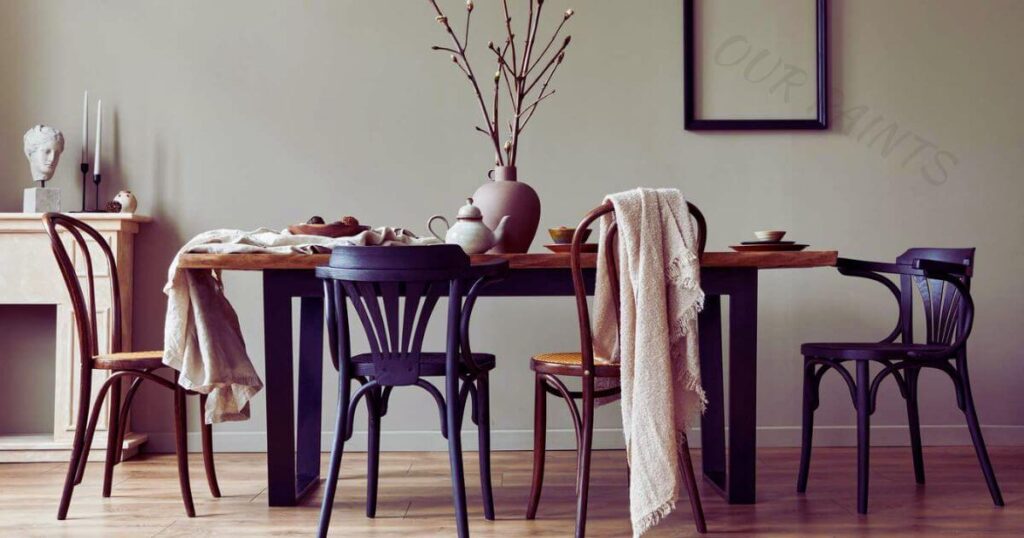
Understanding Color Psychology: A Dive into Emotional Significance
Color psychology serves as the foundation for crafting a captivating ambiance within your dining room. Each color possesses a unique emotional resonance, profoundly impacting the mood and atmosphere of the space.
Delving into this intricate science unveils the profound effects that different hues can evoke. Reds, Oranges, and Stimulating Conversations: Warm tones such as passionate reds and vibrant oranges are renowned for their ability to stimulate conversation and appetite.
These hues exude energy and warmth, encouraging lively interactions among diners. Red, often associated with passion and excitement, can elevate the dining experience by creating a sense of urgency, perfect for intimate gatherings or festive occasions.
Oranges, with their cheerful and inviting nature, add a touch of warmth, making the dining area inviting and convivial. Blues, Greens, and Serene Elegance: On the contrary, cooler shades like calming blues and soothing greens introduce a sense of tranquillity and sophistication.
Blue hues evoke feelings of calmness and relaxation, ideal for fostering a serene dining experience. Incorporating shades of green, reminiscent of nature, brings a refreshing quality to the room, promoting a sense of balance and harmony.
These colors are exceptionally suitable for formal dining settings or when aiming for a sophisticated, elegant atmosphere.
Crafting the Desired Ambiance: Impactful Color Selection
When contemplating color choices for your dining room, consider the intended emotional impact. Reflect on the overall ambiance you wish to create and the dining experiences you aim to foster. Acknowledge the importance of balance and harmony in utilizing colors to evoke specific emotions.
The selection of a primary color palette lays the groundwork for the room’s ambiance. Whether opting for warm, inviting tones or cooler, calming shades, it’s essential to strike a balance. Combining complementary colors can create a visually appealing contrast, while analogous colors offer a harmonious blend.
Integrating accent colors strategically can accentuate certain elements or areas within the dining room. These pops of color add depth and intrigue without overwhelming the space, allowing for a nuanced and layered ambiance that engages the senses and elevates the dining experience.
Harmonizing Elements Balancing Color and Space:
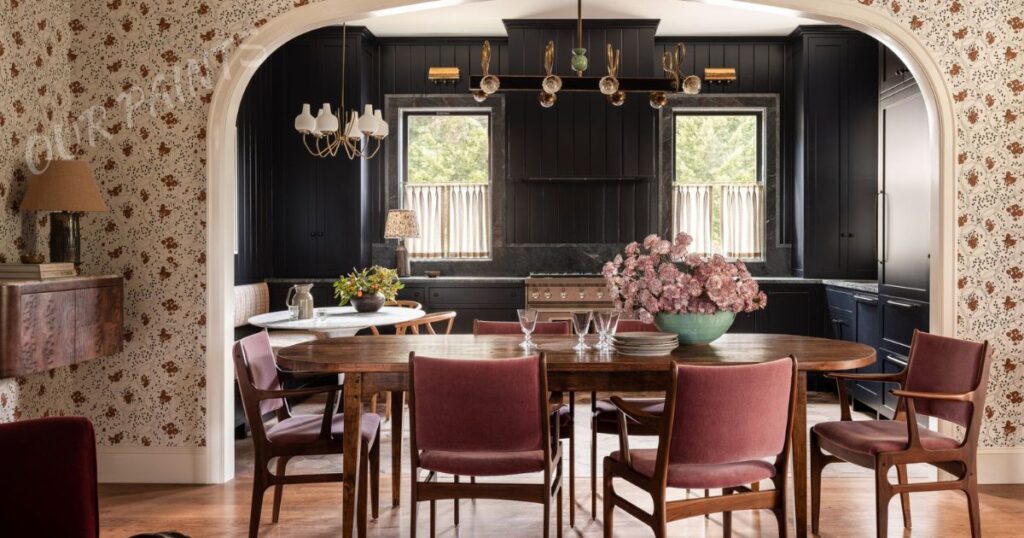
Synergy of Design Elements: A Unified Color Symphony
Harmonizing colors within a space transcends mere selection—it’s a meticulous orchestration involving various design elements. From architectural nuances to the interplay of lighting and furniture, every facet plays a vital role in the color scheme’s coherence and visual impact.
Architectural Blueprint: Integrating Colour Sensibilities: The dining room’s architecture forms the canvas on which the color palette unfolds. Analyze the room’s structure, considering elements like moldings, trims, and ceiling details.
Each component presents an opportunity for color integration, allowing for a cohesive and harmonious visual flow. Embrace the architectural elements as allies in your quest for color balance and spatial harmony.
Lighting, Furniture, and Theme: A Triumvirate of Influence: Beyond the walls’ hues, the influence of lighting fixtures, furniture choices, and overarching thematic elements cannot be overstated.
Lighting fixtures significantly alter how colors are perceived and should align with the chosen palette to accentuate or soften specific shades. Furniture acts as both functional and aesthetic components, contributing to the overall color balance.
The theme sets the tone—whether contemporary, rustic, or eclectic—guiding color choices and ensuring a cohesive visual narrative.
Colour Composition: Strategic Balance and Cohesion
Crafting a harmonious color blend necessitates a strategic approach that integrates a primary color with supporting accent tones. The primary color serves as the foundational hue, enveloping the room and setting the overall ambiance.
It should resonate with the room’s purpose and the emotions you wish to evoke. Accent tones play a pivotal role in adding depth and visual interest. Experimentation with complementary or analogous color schemes introduces contrast or harmony, respectively.
Complementary colors, positioned strategically, create dynamic visual impact through their inherent contrast. Analogous colors, sharing similar undertones, offer a subtler, more unified appearance, ensuring a sense of cohesion without overpowering the space.
Consider the distribution of colors across the room. Balancing these hues spatially ensures an even distribution of visual weight, preventing any single color from dominating the space and disrupting the desired harmony.
The aim is a cohesive amalgamation where each color and element collaborates seamlessly to enhance the dining room’s aesthetic allure and comfort.
Texture And Finish Elevating Visual Appeal:
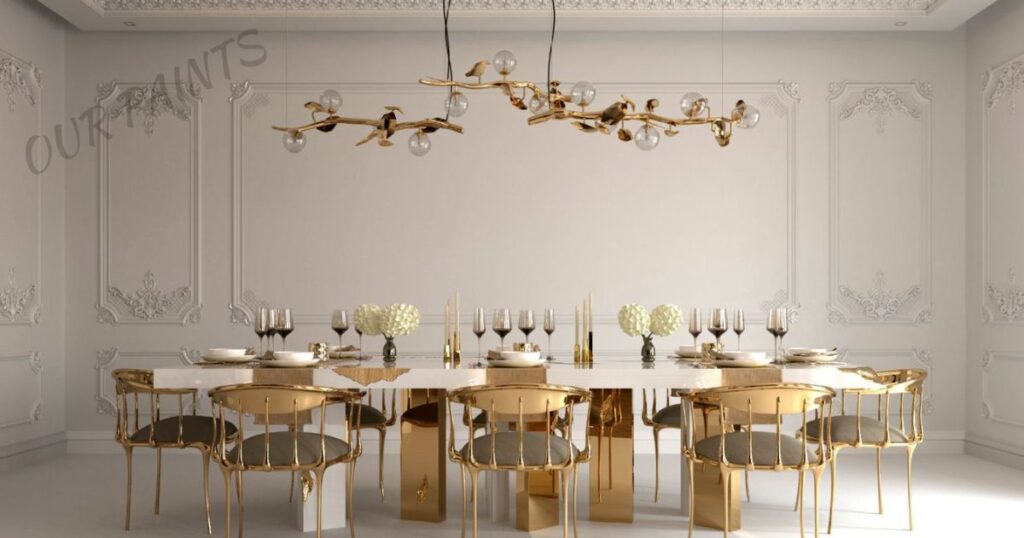
Textural Elegance: Enhancing Visual and Tactile Experience
Texture and finish serve as the unsung heroes in the realm of interior design, significantly impacting the visual appeal and tactile experience within a dining room. Beyond color, these elements add depth, richness, and a tactile dimension, elevating the overall aesthetic to a higher plane of sophistication and allure.
Finishes A Spectrum of Visual Dynamics:
The choice of paint finish stands as a crucial determinant in dictating the room’s ambiance. Matte finishes exude a subtle, understated elegance, offering a smooth, non-reflective surface that absorbs light, ideal for creating a cozy, intimate atmosphere.
Glossy finishes, on the other hand, reflect light, amplifying brightness and imbuing the room with a sense of vibrancy and spaciousness. Satin or eggshell finishes strike a delicate balance between the two, imparting a gentle sheen while concealing imperfections, suitable for high-traffic areas like dining rooms.
Textural Resonance Infusing Dimension and Character:
Introducing textured finishes unveils a realm of design possibilities. Textured paints, such as suede or metallic finishes, add depth and intrigue to the walls, transforming them into focal points within the dining room.
These finishes create tactile interest, inviting touch and exploration, while simultaneously enriching the visual appeal. Incorporating textured wallpapers or faux finishes can further augment the room’s character, evoking a sense of luxury or rustic charm, depending on the chosen texture.
Strategic Implementation: Finesse in Texture and Finish Selection
Incorporating texture and finish within the dining room design requires a strategic and thoughtful approach. Each choice should align harmoniously with the room’s overall theme and color scheme while contributing to the desired ambiance.
Consider the interplay between different textures—combining smooth, glossy surfaces with textured elements or matte finishes with intricate wall textures—to create a balanced and visually engaging environment.
Employing textured finishes strategically on accent walls or architectural features draws attention and adds a layer of sophistication without overwhelming the space. Moreover, the selection of textures should complement the room’s functionality.
In high-traffic areas like dining rooms, durable finishes that withstand cleaning and maintenance while retaining their visual appeal are paramount.
Assess the practicality of the chosen textures alongside their aesthetic allure to ensure a seamless fusion of beauty and functionality, ultimately enhancing the dining room’s overall sensory experience.
Statement Walls And Focal Points Highlighting Creativity:
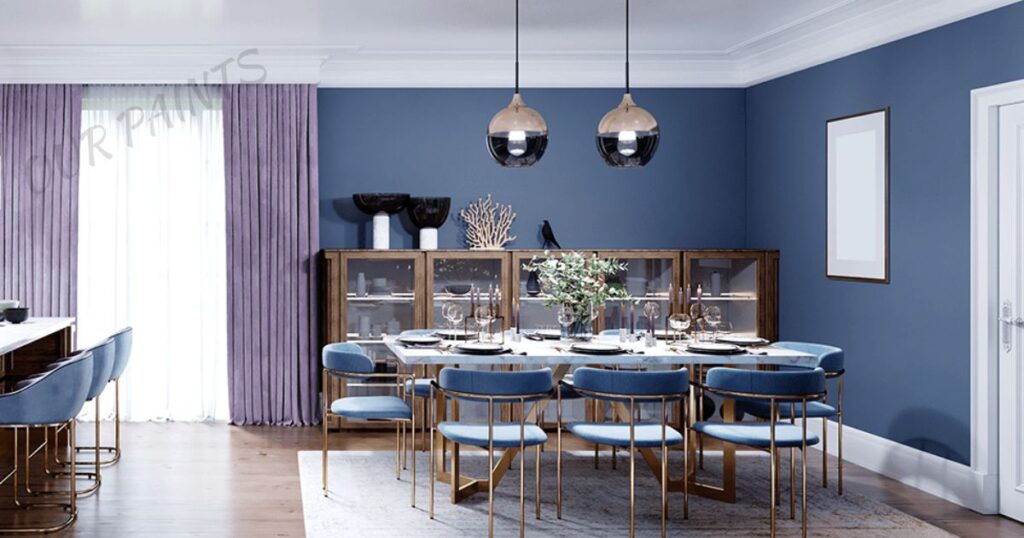
Unleashing Creativity: Statement Walls and Focal Points
Amidst the canvas of your dining room, the concept of statement walls and focal points stand as an artistic endeavor, offering a platform to infuse creativity and personality into the space. These design elements wield the power to captivate attention, evoke emotion, and serve as the visual centerpiece of the room’s narrative.
Statement Walls Vibrant Expressions of Personality:
A statement wall, adorned with captivating colors, textures, or patterns, acts as a bold declaration within the dining room’s design. It’s an opportunity to experiment with daring hues or striking wallpapers that transcend the conventional, instantly drawing the eye and igniting conversation.
Whether through a dramatic mural, intricate wallpaper, or a splash of vivid color, the statement wall speaks volumes about your style and artistic inclination.
Focal Points Curating Visual Emphasis:
Beyond the walls themselves, creating focal points within the dining room amplifies its charm and visual interest. Focal points can range from an artfully designed centerpiece, an elegant chandelier, or an architectural element accentuated with creative detailing.
These elements serve as anchors, directing attention and guiding the eye through the space while showcasing your creativity and design finesse.
Strategic Implementation: Crafting Visual Magnificence
Crafting statement walls and focal points necessitates a strategic and meticulous approach, considering both artistic expression and spatial harmony.
When conceptualizing a statement wall, assess its placement within the room. Opt for a wall that naturally draws attention upon entry or position it as a backdrop for the dining table to command focus during meals.
Experiment with various techniques—color blocking, geometric patterns, or textured finishes—to create a visual spectacle that complements the room’s overall aesthetic. Similarly, when curating focal points, consider their interaction with the surrounding elements.
Ensure they harmonize with the statement wall or color scheme, enhancing rather than competing for attention. Lighting plays a crucial role in accentuating these focal points.
Illuminating them in a way that amplifies their impact within the dining room, creating a cohesive visual narrative that encapsulates your unique design sensibilities.
Lighting Dynamics Enhancing Color Dynamics:
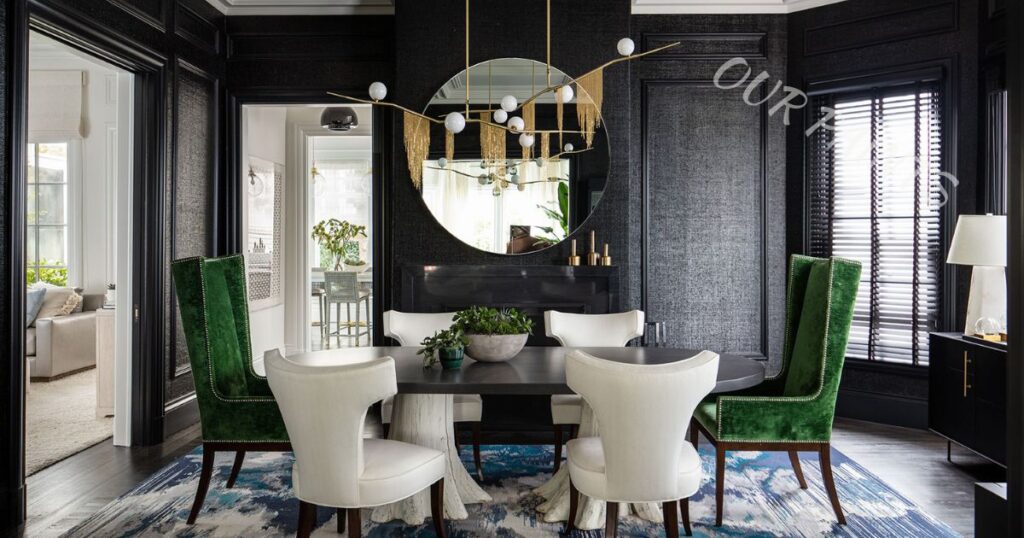
Lighting Dynamics: Mastering Color Dynamics
The realm of lighting within a dining room transcends mere illumination—it holds the transformative power to accentuate color dynamics, evoke moods, and craft a mesmerizing atmosphere. Understanding lighting’s interplay with color forms the cornerstone of a captivating dining room ambiance.
Color Perception Illuminating Hues:
The choice of lighting profoundly influences how colors are perceived within a space. Natural light, with its varying intensities throughout the day, showcases colors differently compared to artificial lighting sources.
Daylight unveils the truest representation of hues, highlighting their nuances and depth. Artificial lighting, including ambient, task, and accent lighting, has the potential to alter color perception, influencing the ambiance and mood within the dining room.
Creating Ambiance Intertwining Light and Color:
Lighting serves as a tool for manipulating the ambiance of the dining room. Warm-toned lighting fixtures, such as incandescent or warm LED bulbs, enhance the vibrancy of warm color schemes, intensifying reds and oranges while adding a cosy, inviting glow.
Cool-toned lighting, like fluorescent or cool LED lights, complements cooler color palettes, intensifying blues and greens, contributing to a serene, elegant atmosphere.
Strategic Illumination: Crafting Visual Brilliance
Strategically harnessing lighting dynamics to enhance color dynamics involves a meticulous approach aimed at accentuating the room’s color scheme and architectural elements.
Consider layering different lighting sources to create depth and dimension. Ambient lighting provides overall illumination, setting the mood and highlighting the room’s color palette.
Task lighting focuses on specific areas, such as the dining table, illuminating it for practical purposes while complementing the room’s ambiance. Accent lighting, directed towards statement walls or focal points, adds drama and visual interest, accentuating their colors and textures.
Moreover, incorporating dimmers allows for control over lighting intensity, facilitating the adjustment of ambiance to suit various occasions. Experimentation with lighting angles and fixtures further enhances the interplay between light and color.
Wall washers, recessed lighting, or strategically placed lamps can accentuate specific colors, casting shadows or highlights that emphasize the room’s color dynamics.
Conclusion:
Crafting a distinctive paint scheme for your dining room involves a delicate orchestration of color psychology, texture, lighting, and focal points. Each element contributes to a cohesive narrative, transforming the space into a personalized haven that reflects your style and evokes desired emotions.
From understanding the emotional impact of colors to strategically balancing different hues and textures, every decision shapes the ambiance. Integrating statement walls or focal points amplifies creativity, while mastering lighting dynamics enhances color dynamics, enriching the room’s visual depth.
Ultimately, a thoughtful fusion of these elements culminates in a dining room that not only showcases your individuality but also elevates the dining experience for you and your guests, leaving a lasting impression of style and sophistication.
Faqs About Unique Paint Scheme For Dining Room:
What’s the importance of a unique paint scheme for a dining room?
A unique paint scheme is crucial as it sets the tone for the dining experience. It defines the ambiance, influences mood, and reflects personal style. A carefully curated scheme can transform a mundane dining area into a captivating space that enhances social interactions and elevates meal times.
How do I choose the right color scheme for my dining room?
Consider the room’s purpose and your desired ambiance. Warm colors like reds or oranges foster lively conversations, while cooler tones like blues and greens create a serene environment. Harmonise with existing décor and architectural elements for a cohesive look.
Can I experiment with textures and finishes in my dining room’s paint scheme?
Absolutely! Textures and finishes add depth. Matte paints create an intimate setting, while glossy ones amplify brightness. Experimenting with textures like suede or metallic finishes infuses a touch of luxury or uniqueness, adding visual interest.
Are statement walls a good idea for a dining room?
Statement walls can be striking They offer a chance to showcase creativity through bold colors, captivating wallpapers, or textured finishes. They act as a focal point, adding personality without overwhelming the space.
How does lighting impact a unique paint scheme in a dining room?
Lighting is key! It affects how colors are perceived. Warm lighting complements warm color schemes, while cool lighting accentuates cooler tones. Layering different light sources adds depth and enhances color dynamics.
Should I focus on creating a focal point within the dining room’s paint scheme?
Yes, a focal point—be it an art piece, an accent wall, or a unique lighting fixture—adds visual interest. It guides the eye and contributes to the room’s aesthetic, creating a captivating centerpiece.
Can I mix different color schemes or styles in my dining room’s paint scheme?
Absolutely! Mixing complementary or analogous color schemes can add depth and intrigue. Balancing these colors strategically ensures a cohesive and visually appealing dining room, allowing for a personalized touch without losing harmony.

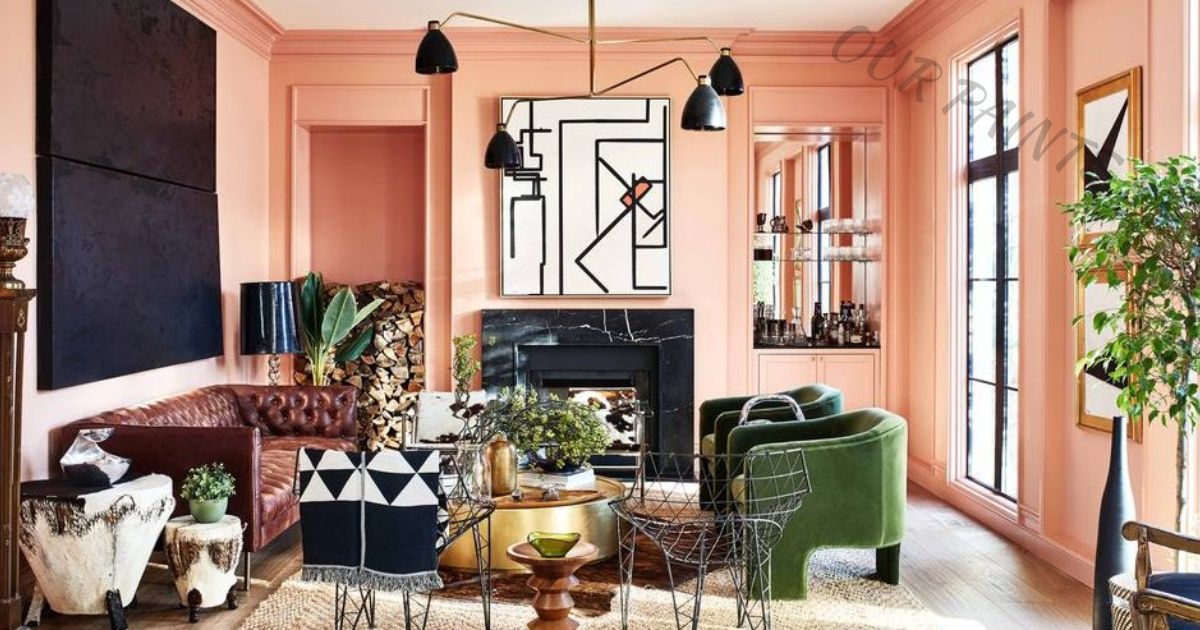
Thank you for your sharing. I am worried that I lack creative ideas. It is your article that makes me full of hope. Thank you. But, I have a question, can you help me?